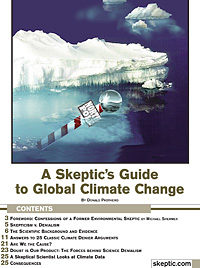In this week’s eSkeptic:
New at Shop Skeptic
The paperback edition of…
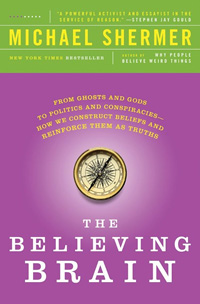
NEW PAPERBACK EDITION
Order the paperback
Order the Kindle Edition
Order the iBook
Order the Audiobook from Apple
Order the Unabridged Audio CD
Download a reading of the Prologue
THE BELIEVING BRAIN
From Ghosts, Gods, and Aliens to Conspiracies, Economics, and Politics—How the Brain Constructs Beliefs and Reinforces Them as Truths
Dr. Michael Shermer presents his comprehensive theory on how beliefs are born, formed, nourished, reinforced, challenged, changed, and extinguished. His thesis is straightforward:
We form our beliefs for a variety of subjective, personal, emotional, and psychological reasons in the context of environments created by family, friends, colleagues, culture, and society at large; after forming our beliefs we then defend, justify, and rationalize them with a host of intellectual reasons, cogent arguments, and rational explanations. Beliefs come first, explanations for beliefs follow.
We can’t help believing. Our brains evolved to connect the dots of our world into meaningful patterns that explain why things happen. These meaningful patterns become beliefs. Once beliefs are formed the brain begins to look for and find confirmatory evidence in support of those beliefs, which adds an emotional boost of further confidence in the beliefs and thereby accelerates the process of reinforcing them, and round and round the process goes in a positive feedback loop of belief confirmation.
This book synthesizes over 30 years of research to answer the questions of how and why we believe what we do in all aspects of our lives, from our suspicions and superstitions to our politics, economics, and social beliefs.
Also new at Shop Skeptic…
A SKEPTIC’S GUIDE TO
GLOBAL CLIMATE CHANGE
By popular request, we bring you A Skeptic’s Guide To Global Climate Change, by Donald R. Prothero. Distinguish climate change skepticism from climate change denialism; get 25 answers to classic climate denier arguments; examine a summary of the scientific evidence and climate data and discover what’s behind the debate on climate change; find out why scientists think climate is changing and how we know global warming is real and human caused. This booklet has 28 pages at 8.5 × 11 inches.
Table of Contents
- Foreword by Michael Shermer: “Confessions of a Former Environmental Skeptic”
- Skepticism v. Denialism
- The Scientific Background and Evidence
- Answers to 25 Classic Climate Denier Arguments
- Are We the Cause?
- Doubt is Our Product: The Forces Behind Science Denialism
- A Skeptical Scientist Looks at Climate Data
- Consequences
Multiple Copy Deal
Save on multiple copies of any combination of these other handy booklets:
- A Skeptic’s Guide to Global Climate Change
- How to Debate A Creationist
- The Baloney Detection Kit
- The Soul of Science
The Discounts
- 5 or more: 10% off
- 10 or more: 15% off
- 25 or more: 20% off
- 50 or more: 30% off
For larger orders call for additional discounts: 1-626-794-3119.

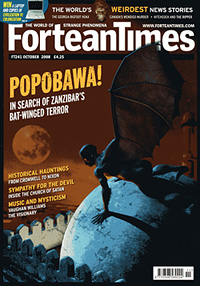
Assault & Giant Battery
For decades, legends of a giant sexually-assaulting bat-creature have trickled out of Zanzibar. In this episode of MonsterTalk we interview Ben Radford about his investigation of the creature and the role that the monster called Popabawa has played in culture and politics in the United States.
Get the MonsterTalk Podcast App
for Apple and Android Devices!
Get the MonsterTalk Podcast App (presented by Skeptic Magazine) and enjoy the science show about monsters on your handheld devices! Available for Android, iPhone, iPad, and iPod Touch. To get the app for iOS devices, download the free Podcast Box App on iTunes and then search for MonsterTalk within the Podcast Box app to listen to Monstertalk on your iPhone, iPad or iPod. For Android devices, simply install the stand-alone app.
Screenshots from the iPhone App
About this week’s eSkeptic
In this week’s eSkeptic, Glenn Branch reviews Brook Wilensky-Lanford’s book Paradise Lust: Searching for the Garden of Eden (New York: Grove Press, 2011, ISBN 978-0-80211-980-3).
Glenn Branch is deputy director of the National Center for Science Education, a non-profit organization that works to defend the teaching of evolution and climate science in the public schools. With Eugenie C. Scott, he coauthored The Latest Face of Creationism for the January 2009 issue of Scientific American.
Eden Sought
a book review by Glenn Branch
Where on earth was the Garden of Eden? At first, Genesis 2 seems to be helpful, identifying four rivers flowing from Eden with their associated landmarks: the Pison, “which compasseth the whole land of Havilah”; the Gihon, “which compasseth the whole land of Ethiopia”; the Hiddekel (also known as the Tigris), “which goeth toward the east of Assyria”; and the Euphrates. With a handful of familiar names to help, surely it ought to be possible to pinpoint the site where God created Adam and Eve and from which they were expelled after eating the forbidden fruit. But, as Brook Wilensky-Lanford describes in Paradise Lust, it isn’t so simple. Even restricting her attention to works published after Darwin’s Origin of Species and before 1971—the year in which her great-uncle, himself a searcher after Eden in the 1950s, died—she found that “the Garden of Eden had been found in Iraq, Turkey, Sri Lanka, Mongolia, the Seychelles, Florida, California, Missouri, and Ohio; at the North Pole; under the Mediterranean near Crete; in Sweden, the Persian Gulf, and Egypt” (p. xi).
The searchers she presents are colorful and varied, including the maverick anthropologist Thor Heyerdahl, who brought his characteristic do-it-yourself approach to bear, constructing and piloting a reed craft to retrace the travels of the ancient Sumerians. Less famous but equally interesting were a Methodist theologian who served as the first president of Boston University (it was he who located Eden at the North Pole), a minister who felt that the Serpent Mound in southern Ohio memorialized the tempter of Eve, a Florida lawyer who admired Clarence Darrow and argued court cases for the NAACP, the unidentified channeled author of The Urantia Book, and a scattering of more or less serious scholars. The chapter on Tse Tsan Tai, a Chinese nationalist who cofounded the South China Morning Post and located Eden in central Asia, was particularly intriguing. Wilensky-Lanford notes that Tse’s father was a player in the Taiping Rebellion; it would have been interesting to know what Hong Xiuquan, whose eccentric version of Christianity sparked the rebellion, thought about Eden and whether his views influenced Tse’s.
Each chapter is well-written and well-crafted, although toward the end of the book a certain repetitiveness emerges, and it is a bit of a relief that three modern archaeologists are considered together in the penultimate chapter. Throughout, Wilensky-Lanford generally provides a sympathetic account of her subjects. The seekers after Eden are often wrong, but their motivations are generally understandable if not always commendable. She rarely scolds them for stupidity or malice, and when she deplores one scholar’s descent into a vicious anti-Semitism, it’s perfectly in order. One criticism she launches is needlessly captious: noting that one author wrote of “hyperborean Eocene man” in the Garden of Eden at the North Pole, Wilensky-Lanford comments, “the first apes didn’t appear on earth until about 30 million years after the Eocene epoch” (p. 19). But the word “Eocene”—coined by William Whewell to mean “the dawn of the recent era”—is amenable to a figurative use, meaning early or rudimentary. A distinguished precedent is Darwin: writing to Joseph Hooker in 1856, he described a colleague’s deficient grasp of geology as “rather eocene.”
Considered as a roughly chronological series of vignettes of people who have speculated about the location of Eden, Paradise Lust succeeds, and succeeds admirably. It makes no pretense of providing a complete encyclopedic treatment, which is just as well—such a treatment would be monotonous and tedious. Still, it is disappointing to see no more than a passing mention of Charles George Gordon, the British general who located Eden on the island of Praslin, in part on the basis of what his biographer Charles Chevenix Trench describes delicately as “the remarkable similarity between the ripe fruit of the Coco de Mer, a gigantic palm tree, and Eve’s pudenda.” And there is no mention of the eccentric Irish peer and ufologist Brinsley Le Poer Trench, who in his 1960 book The Sky People endorsed the idea that the rivers of Genesis must be canals, but astutely noted, “If such a canal system, as described in Genesis[,] even existed on this earth, there is no trace nor record of it.” But there is a place, he continued, that abounds with canals and thus must have been the site of Eden: Mars.
Where Paradise Lust stumbles is in its overall argument. In the prologue, Wilensky-Lanford suggests that the Origin of Species provoked a “major plot twist” in the search for the historical Eden; she stops halfway through her book to discuss the Scopes trial, portraying it as pivotal; and she devotes a chapter to the Creation Museum operated by the young-earth creationist ministry Answers in Genesis and the praiseworthy efforts of the science educator Lee Meadows (himself a church-going and Sunday-school-teaching Christian) to combat creationism’s pernicious influence on the teaching of evolution. Her idea seems to be, then, that what evolution says about human origins was important for the quest for the historical Eden. But on her own account, it wasn’t. Her subjects weren’t, by and large, engaged with the evidence of the paleoanthropological record; they weren’t struggling with how to understand—or dismiss—the discoveries of Eugène Dubois or Raymond Dart in the light of their readings of Genesis. Rather, they were engaged with the evidence afforded by the archaeology of the Ancient Near East.
Ancient Near East archaeology, like evolutionary biology, began in earnest in the 19th century, and like evolutionary biology, its effect on traditional religious belief was transformative, contentious, and incomplete. Initially, the discipline seemed to promise to demonstrate that the Bible was a reliable source of information—for the history of ancient Israel, certainly, if not necessarily for the “primeval history” of Genesis 1–11. With increasing professionalization, however, the promise was unfulfilled. Those who were interested primarily in conducting objective scholarship took increasingly secularizing approaches. About half of Wilensky-Lanford’s subjects—Delitzsch, Sayce, Willcocks, Heyerdahl, Zarins, Rohl, and Sanders—appear not to have taken the idea that creation occurred in Eden seriously, even though they accepted to varying degrees that it was possible to identify a place corresponding to the Eden of Genesis 2; it would have been useful for their work to be placed in a broader context of the development of archaeology and for figures such as the dean of biblical archaeology, William F. Albright, to be discussed as well.
Meanwhile, those of Wilensky-Lanford’s subjects who believed that creation occurred in Eden increasingly were on the fringe. As she aptly writes, “the search for a literal Eden did not die. It just got weird” (p. 138). Warren and West were ministers, but never convinced the denominations to which they belonged of the validity of their views; Tai and Callaway were eccentric laymen with limited influence; and the Mormons and the Urantians have long been considered to be outside of the religious mainstream in the United States (although the former are making strides toward general acceptance). The exception here is the proprietors of the Creation Museum and young-earth creationists in general. Even though their views are rejected by the vast majority of theologians, they are lamentably influential: Gallup reports that about a third of Americans accept biblical literalism, and almost half accept creationism, if not necessarily the young-earth variety. But the Creation Museum is not a persuasive counterexample in any case, for Answers in Genesis regards the present whereabouts of Eden as unknowable, due to Noah’s Flood, and unimportant.
It is tempting, in fact, to think that the discussion of the Creation Museum was added late to the book, to comport with the implicit (and faulty) argument of the prologue and the interlude linking evolution and Eden. It is perhaps significant that there are minor but annoying errors throughout the chapter. On p. 204 alone, Wilensky-Lanford writes that the flamboyant young-earth creationist Kent Hovind was imprisoned for tax fraud in 2009 (actually, in 2007); that Hovind contends that the dinosaurs all perished in Noah’s Flood (actually, he suspects that they are still with us, citing the possibility that the Loch Ness monster is a plesiosaur—which, of course, is not a dinosaur); that scientists think that dinosaur remains “may be up to 60 million years old” (actually, except for birds, dinosaur fossils date from about 230 million to about 65 million years ago); and that the poll question on creationism and evolution used by Gallup addresses the age of the earth (actually, it only discusses the timing of the appearance of humanity).
So it would be a mistake to read Paradise Lust in the hope of finding a cogent explanation of the history of the modern search for the historical Eden. No matter: the book is fascinating as it stands. A map of the world on the endpapers and a map of the area northwest of the Persian Gulf on the frontispiece are helpful, and twelve plates of photographs of the authors and their books and maps add to the interest; regrettably, there is no index. While the research is generally solid, the presentation is anything but dry; while the topic is often amusing, the presentation is only occasionally droll. Thus commendably navigating between the temptations of pedantry and frivolity, Wilensky-Lanford also imbues her accounts of the seekers after Eden with a novelist’s flair. A representative, and favorite, passage: “Tse didn’t bother with careful proofs: science inspired him to revisit the Bible. His answers came as a series of lightning bolts, like those that flashed outside his window as he put the finishing touches on his book” (p. 91). ![]()
Skeptical perspectives on evolution and creationism…
-
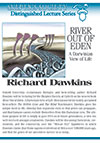 River Out of Eden:
River Out of Eden:
A Darwinian View of Life
by Dr. Richard Dawkins -
Evolutionary biologist Dawkins continues his train of evolutionary reasoning from his previous bestselling works, The Selfish Gene and The Blind Watchmaker. Dawkins hammers home point after point showing why creationism is simply and obviously wrong. He also examines the African Eve theory and discusses current controversies in evolutionary theory. A brilliant lecture by one of the greatest scientists of our time.
-
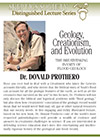 Geology, Creationism & Evolution:
Geology, Creationism & Evolution:
The Breathtaking Inanity of Flood Geology
by Dr. Donald Prothero -
Have you ever had to deal with a Creationist who takes the Genesis accounts literally, and who insists that the biblical story of Noah’s flood can account for all the geologic features of the earth, as well as all the creatures that survived on the ark? In this lecture, Dr. Prothero discusses the biblical and logistical problems with “flood geology,” and shows how creationists’ conception of the geologic record would mean that we would never find coal, oil, gas or other natural resources that our society needs. In this engaging and richly illustrated lecture, Prothero provides a wealth of evidence and answers to creationist challenges to science…
-
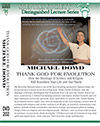 Thank God for Evolution: How the Marriage of Science and Religion Will Transform Your Life and Our World
Thank God for Evolution: How the Marriage of Science and Religion Will Transform Your Life and Our World
by Michael Dowd -
The Reverend Michael Dowd is one of the most inspiring speakers in America today. His lecture/sermon is based on his bestselling book, Thank God for Evolution: How the Marriage of Science and Religion Will Transform Your Life and Our World, which has been endorsed by 5 Nobel Prize-winning scientists and dozens of other scientific and religious luminaries across the spectrum. Since April 2002, he and his wife, Connie Barlow, an acclaimed science writer, have lived permanently on the road sharing a sacred view of evolution with religious and secular audiences of all ages, as America’s evolutionary evangelists…


